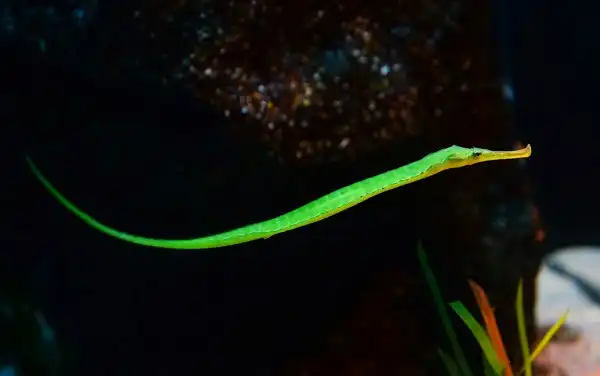Pipefish are a type of fish that are closely related to seahorses. They are found in tropical and subtropical waters around the world. Pipefish are known for their long, thin bodies and their upturned mouths. Some species of pipefish can grow to be over a foot long, while others are only a few inches long. Pipefish are relatively rare compared to other types of fish, but they play an important role in the ecosystems where they live.

Pipefish Description
Pipefish have long, thin bodies that are usually covered in scales. Some species have brightly colored stripes and patterns on their bodies, while others are more muted in color. They have an upturned mouth which is used to suck up small prey like plankton and crustaceans. Their fins are short, typically not extending past the end of the body.
These fish form complex social systems with interactions between males, females, and juveniles. Males are often seen guarding their eggs until they hatch while females take care of their young until they become independent swimmers. Pipefish also play an important role in maintaining balance within reef ecosystems since they act as both predators of smaller organisms as well as food for larger ones such as sharks or eels. Although pipefish are relatively rare compared to other types of fish, their presence is essential for maintaining healthy marine environments.
Pipefish Habitat
Pipefish are most commonly found in warm, shallow waters of the tropical and subtropical oceans. They can be seen in coral reefs or near ocean currents where there is plenty of food and shelter. Pipefish are also known to inhabit estuaries and mangroves, as well as coastal lagoons in some areas. In addition to their natural habitats, pipefish have been successfully kept in aquariums.
As long as their tanks provide enough space for them to swim around freely, adequate water temperatures, and plenty of live food like plankton or shrimp, these fish can thrive in captivity. While pipefish may not be the most well-known type of fish out there, they’re an important part of the ecosystem and make a wonderful addition to any aquarium. With their unique shapes and colors, pipefish are sure to bring some beauty and life into your home.

Pipefish Diet
Pipefish primarily feed on small organisms like plankton, shrimp, and other crustaceans. As they have an upturned mouth, they are able to suck up their prey with ease. While some species of pipefish can be kept in aquariums and fed frozen food or pellets, it is best to provide them with a variety of live foods whenever possible. In the wild, pipefish also feed on small fish fry or eggs that drift through the water column. They will sometimes even eat algae off of rocks and coral reefs when there is not enough food available for them to find elsewhere. Pipefish are also known to scavenge for dead matter such as pieces of fish or crustaceans in order to supplement their diet.
Pipefish Size
Pipefish come in a variety of sizes, from just a few inches to over 12″ long. Although some species which inhabit deeper waters may reach up to 15″, the majority seem content with being between 4-10″. As such, pipefish remain relatively small throughout their lives and rarely exceed those dimensions when fully mature.
Pipefish Lifespan
Pipefish are an immensely intriguing species of fish that can bring a unique vibrancy and charm to any aquarium, lasting up to 10 years when cared for properly. While their lifespan varies due to factors such as the environment or specific species, many pipefish have been observed living from 3-7 years in the wild. Not only do they provide hours of entertainment value with their vibrant colors and interesting shapes but also contribute invaluably towards healthy reef ecosystems around the world!

Pipefish Behavior
Peaceful pipefish often congregate in small groups, gracefully gliding through the water as they hunt for nourishment. When threatened by predators or potential harm, these remarkable creatures are able to tighten into a spiral shape and hide amongst rocks and coral – using their slime-like mucus coating as an additional layer of protection. They also possess unique sounds which help them communicate with each other when near one another; making noises ranging from low hums to pops and clicks depending on the species.
Pipefish Speed
Even though they lack the speed of other fish species, pipefish are able to make up for it with their maneuverability. The rate at which each species swims may vary but generally ranges from 10 centimeters per second. In comparison, some marine creatures like tuna can move at a much faster 50 kilometers an hour! While this agility helps them in hunting and navigating tight spots underwater – ultimately being slower means that Pipefish must rely on sharper tactics instead of sheer velocity when searching for sustenance or avoiding danger

Pipefish Hunting
Pipefish hunt mostly by ambush, using their long slender bodies to hide in crevices or among coral and wait for unsuspecting prey to pass by. They will then quickly dart out to snatch it up before retreating back into the safety of their hiding place. Pipefish have an upturned mouth which allows them to suck up their prey with ease and makes them especially adept at catching tiny creatures like plankton and copepods.
Conclusion
With their bright, captivating colors and mesmerizing shapes, it is easy to see why pipefish have become a popular addition to saltwater aquariums all over the world. These miniature marvels provide hours of entertainment with their curious behaviors that can be observed up close more easily than other fish. What’s more, these delightful creatures are essential for maintaining healthy reef ecosystems! With an unforgettable presence and fascinating personalities – both big and small – there is no doubt that pipefish make a unique contribution to our oceans’ delicate balance of life-supporting species.
Frequently Asked Question

